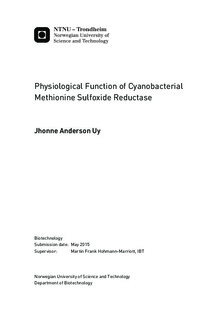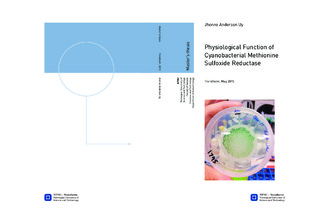| dc.description.abstract | Methionine is a sulfur-containing amino acid which is susceptible to oxidation by Reactive Oxygen Species (ROS). Oxidation of methionine could lead to protein denaturation; with methionine itself turning into methionine sulfoxide (MetSO), a radical which further damages other cellular components. To prevent these damages, the cell uses antioxidizing enzymes which reduce MetSO back to methionine. These enzymes are called methionine sulfoxide reductase (MSR). MSR is divided into two types which correspond to each MetSO diastereomers. The first type is MSRA which shows specificity towards S-MetSO, while the second is MSRB to R-MetSO. These MSR genes are highly conversed and widely distributed amongst the animal and plant kingdom, suggesting their importance in the repair of oxidative damage. The cyanobacterium, Synechocystis PCC 6803 (PCC 6803), contains two MSRA (slr1795 and sll1394) and one MSRB. The function of these MSRs for this organisms' physiology, however, is still poorly defined. The main objective of this research was to therefore characterize MSRs functionality in PCC 6803. In order to do so, two mutant strains lacking either the slr1795 or sll1394 MSRA were generated. These mutant strains were then exposed to moderate and high-light intensity experiments with ROS promoting plate conditions to induce oxidative stress. Parameters such as growth rate and doubling time, degree of pigmentation, chlorophyll and carotenoid levels, and colonial morphology were quantified to determine the effect of MSRAs partial absence on the cells' physiology.
Analysis of the experiments revealed that partial absence of MSRA did not necessarily affect the cells overall survivability against oxidative damage; mainly because of the cells many layers of defense against ROS. However, the data gathered from the experiments seem to indicate that the mutant strains were experiencing more stress in comparison to the wild type. In particular, the Δsll1394 strain displayed elevated stress levels on two experiments; the first one being in the high-light experiment, and the second on chlorophyll and carotenoid measurements. Strains exposed to high-light and grown on glucose displayed a decrease in cell density and enter a lag time after 100 hours of incubation, before being able to recover again. Deletion of the sll1394 gene seem to prolong this lag time, suggesting slower repair of the damaged done by ROS. In addition, the Δsll1394 strain also had higher levels of carotenoid in comparison to the other two strains, indicating more sensitivity towards high-light. In summary, the gathered results only gave an initial insight of MSRAs repair and protective functionalities in PCC 6803. Further experiments, such as generation of a double deletion strain, are needed to give a more detailed analysis. | |

